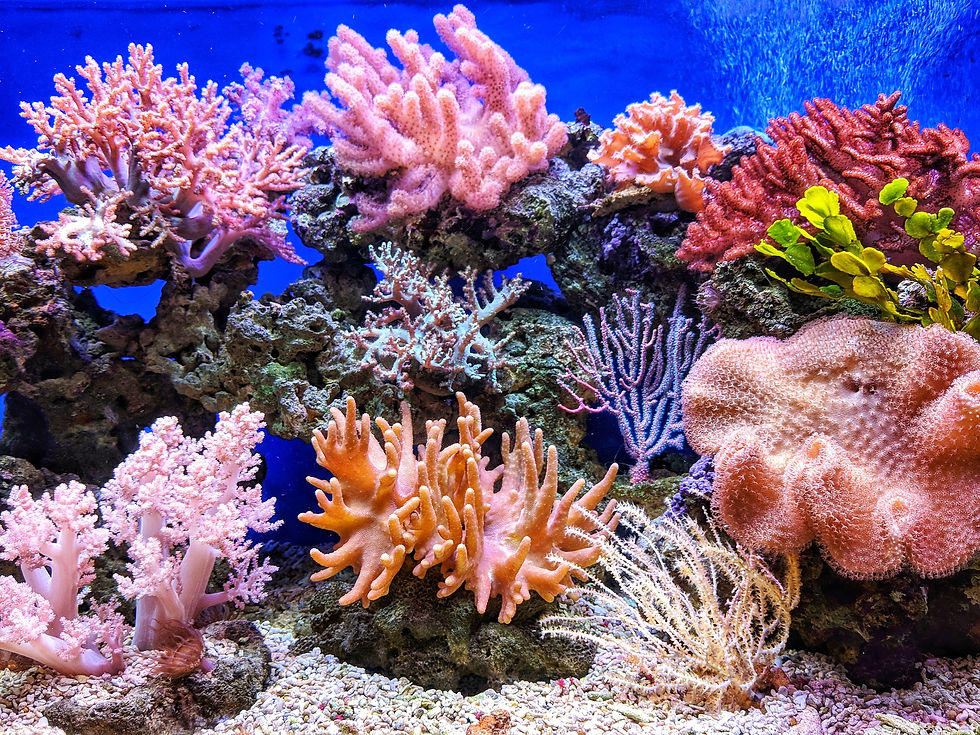Becoming More Conscious About Our Oceans
- Lauren Price

- Jun 24, 2021
- 3 min read
Updated: Aug 16, 2021
Fast fashion is polluting the beautiful and diverse life within our oceans. Simon Reddy laments that “Fish, seabirds, sea turtles, and marine mammals can become entangled in or ingest plastic debris, causing suffocation, starvation, and drowning.” The impact is devastating and, frankly, inhumane.
Various studies concerning marine life highlight the selfishness and thoughtlessness of many fashion industries. However, people are increasingly unwilling to ignore this pressing and often fatal issue. It is important for us all to do our bit to protect the awe-inspiring creatures within our ecosystems. This starts with recognising the dangers of fast fashion.
How fast fashion pollutes our waters
In her article on the circular economy, Lara Fiona McCormick addresses how “The fashion industry’s current practices result in tons of plastic microfibres being tossed into the ocean, having an affect on sea creatures and their quality of life.”
One of the main issues with fast fashion is how quickly trends come and go. With numerous people wanting to keep up to date with what is fashionable, they tend to throw out clothes that have barely been worn. Rather than reusing or recycling old items, they then tend to end up in our oceans, with not enough people within the fashion industry considering the consequences of these actions.
As a result, our waste suffocates more sea creatures, and we run the risk of certain marine life going extinct, something none of us should wish for.
Horrifyingly, Fashion Revolution adds: “Around two thirds of our clothes are made from synthetic fibres, such as polyester, acrylic and nylon, which are all plastics.” Considering how much research has gone into the current state of our oceans, this statistic is deeply disappointing. It shows how enough people are not taking these matters seriously.
Curiously Conscious has listed over 70 fast fashion brands to avoid, or at least to spend less money on. However, many of us continue to be too careless, and the issue extends into how we treat our clothes. We wash them too often, resulting in a plethora of dangerous microfibres entering our oceans. Luckily, with the rise of what is becoming known as “conscious fashion”, many are fighting to protect marine life.
Making fashion more conscious
The Fashion Pact is a global coalition that aims to make fashion more eco-friendly. For instance, its goals are to stop global warming, restore biodiversity, and protect the oceans. As of now, the coalition involves the likes of H&M, Chanel, Selfridges and more. Considering the popularity of these brands, it is reassuring that they are slowly but surely becoming more environmentally conscious.
While conscious fashion brands like Stella McCartney can be much more expensive than fast fashion brands, the clothes tend to be more long-lasting. Conscious fashion clothing is more recyclable and leads to the amount of microfibres entering our oceans decreasing. Conscious fashion brands, then, sell long-term and biodegradable products.
In addition, Fashion Revolution urges governments to fit all new washing machines “With effective filters to ensure maximum capture of microfibres.” Indeed, conscious fashion goes beyond what clothes you buy. It is also concerned with how you treat them.
It is key for us to reduce the amount of days we spend washing our clothes as well. Only washing our clothes when it is necessary will further contribute to the minimisation of water pollution.
Even the colour of our clothing plays a part in saving our oceans. Abigail Gravel asserts that “The fabrics and colours associated with conscious fashion are neutral and natural.” In other words, conscious fashion clothing tends to involve colours that are suitable for any season of the year. As a result, you will get more regular use out of these items, since they will always look trendy.
The balance of trendiness and eco-friendliness
Being both sustainable and fashionable can be a tricky balance to strike. Although conscious fashion brands are admirable for a number of reasons, they sometimes tend to be too expensive for many. Ultimately, however, “Ethical fashion is about people.”
In time, more industries will do what they can to make fashion more affordable and, as a result, more enjoyable. But ethical fashion goes beyond protecting humanity, it also contributes to the fight to save our exciting and mesmerising ecosystems.
The minimisation of water pollution will make our oceans cleaner and safer places for marine life, and will prohibit numerous species from going extinct. Conscious fashion is stylish, long-lasting and participates in the cause to save our oceans.
With these benefits in mind, how could anyone not become that bit more mindful?



Comments